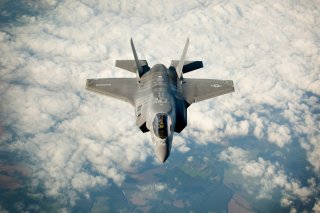Democracy Cannot Be Defended Without a Strong Military Industrial Base
If America is serious about remaining the arsenal of democracy, Washington cannot afford to take its foot off the pedal to increase surge production across the industrial base for munitions, ships, aircraft, and ground vehicles.
Amid extreme budgetary uncertainty in Washington and conflict flaring around the globe, President Joe Biden stressed the importance of America’s role as an “arsenal of democracy” in his Oval Office address last week. The White House backed up this call with the long-awaited announcement of a massive aid package for Ukraine, Israel, allies in the Indo-Pacific, and bolstered production here at home—including of Navy submarines.
While the administration’s supplemental spending request comes at a crucial time to bolster conventional deterrence and reinforce allies, it exposes the deficiency that policymakers allowed to occur over the past three decades of America’s military manufacturing. The surge now required to meet demand for our allies and the US military simultaneously requires the kind of investment the White House proposed, and much more.
Having just enough of select capability on hand only works when every planning assumption is perfect. Unfortunately, Washington bats nearly 1,000 in getting the future wrong. The limited stocks of 155mm artillery shells highlight inadequate supply as these key munitions intended for Ukraine have been hastily rerouted to Israel after Hamas’ massacre two weeks ago. Over and over, policymakers are reminded that the enemy “gets a vote.”
Horrific recent wars highlight mass and attrition are not relics of the past, as shell-hungry armies have devoured upwards of tens of thousands per day. This appetite for artillery blew the cover off America’s brittle defense industrial base, revealing numerous supply chain shortcomings and an inability to surge production of several key explosives after Russia’s invasion of Ukraine.
For this reason, the effort to supply and struggle to produce 155mm artillery shells has served as the newsworthy barometer for the health of America’s munitions industrial base. To be sure, Army leaders are working around-the-clock and posting impressive results (such as doubling production in under one year and on pace to sextuple 155mm production by 2028).
But what if there is no time to surge production after the fighting starts in the next war, particularly if in Asia? All we’ll have on hand is likely all our armed forces could have for weeks or months so it must be more than enough.
As the war in Ukraine drags on and Washington struggles to keep up, the consequences of our malaise have grown ever more apparent. This erosion of our defense industrial base was no accident. It is the result of deliberate policy choices to sacrifice munitions production at the expense of other defense priorities. Munitions have historically served as a billpayer, creating a roller coaster of munitions production in which private industry struggles to maintain their workforces and keep plants operating.
According to Pentagon acquisition chief Bill LaPlante, when hit with budget cuts, the first place the services look are their munitions accounts. Findings from an Army Science Board study support the under-secretary’s claim. When faced the sequestration of the Budget Control Act in the early 2010s, the Army made continuous cuts to its procurement of 155mm artillery shells and other munitions, based off short-sighted analysis of low expenditure rates in Iraq and Afghanistan.
This continuous funding variation discouraged investment, modernization, and production within the Army’s munition industrial base ecosystem. Following budget sequestration, demand was so low that the Scranton Army Ammunition Plant idled production of 155mm shells for two whole years. This shocking decision allowed supply chains to atrophy and set the stage for surge challenges today.
As America scrambles to contain spiraling crises from becoming wider world wars, Pentagon leaders must ensure a strong, consistent demand for munitions and other essential weapons. If America is serious about remaining the arsenal of democracy, Washington cannot afford to take its foot off the pedal to increase surge production across the industrial base for munitions, ships, aircraft, and ground vehicles.
Mackenzie Eaglen is a senior fellow at the American Enterprise Institute (AEI), where she works on defense strategy, defense budgets, and military readiness. She is also a regular guest lecturer at universities, a member of the board of advisers of the Alexander Hamilton Society, and a member of the steering committee of the Leadership Council for Women in National Security.
This article was first published by the American Enterprise Institute.
Image Credit: Creative Commons.

